Akron, Ohio
![]()
This article is about the city of Akron in Ohio. For other meanings, see Akron (disambiguation).
Akron [ˈækrən] is a city in the northeastern U.S. state of Ohio. It is located on the Ohio-Erie Canal, 50 km south of Cleveland, and 85 km from the Pennsylvania border. With an area of 62.41 square miles (161.57 km²) and a population of nearly 200,000 (2016 estimate, U.S. Census Bureau), it is the fifth largest city in Ohio. Akron is the county seat of Summit County and both the geographic and economic center of a metropolitan area of nearly 700,000 residents, the Akron Metropolitan Statistical Area.
The name Akron derives from the Greek word ἄκρος, and its meaning "highest point" refers to the nearby apex of the Ohio-Erie Canal, during the construction of which the city began as a small settlement. After the turn of the century, Akron rose to become the largest location of the U.S. tire industry, with four major plants (Firestone, General Tire, B. F. Goodrich, and Goodyear), growing from 16,500 to 255,000 residents between 1880 and 1930. Other products were airships manufactured by Goodyear (including the USS Akron), kerosene lamps, and oatmeal.
As a result of economic structural change, industrial decline began in the second half of the 20th century and is still noticeable today. The city is successfully combating this with investments in the remediation of contaminated sites, new industrial settlements, school education and industrial research. Akron has important research facilities in the polymer and plastics industry and is the main location of Polymer Valley, where almost half of Ohio's plastics industry is concentrated. The resident university, the University of Akron, has 23,400 students.
In 1935, the self-help organization of Alcoholics Anonymous was founded in Akron.
Geography
Location and extent
Akron is located in northeastern Ohio, about 30 miles (50 km) south of Cleveland on Lake Erie and about 50 miles (85 km) west of the Pennsylvania border. The city area is 62.41 square miles (161.57 km²) in size (of which 160.69 km² is land area) and is located in the center of its constituent county, Summit County. It has a roughly square base shape with two bulges on the east and northwest and several smaller "fringes" on all four sides.
In terms of economic geography, Akron is located in the middle of the Rust Belt and former Manufacturing Belt, the densely populated, first industrial area of the USA, whose former centers are today often marked by the decline of heavy industry. The city is the capital of the associated Akron Metropolitan Statistical Area, which has a population of nearly 700,000. In its neighborhood are three other metropolitan areas, Cleveland in the north with 2.1 million inhabitants, Youngstown in the east with 587,000 inhabitants and Canton in the south with 410,000 inhabitants. The triangle of cities Akron-Canton-Youngstown together form the industrial region Polymer Valley, in which a large number of plastics processing companies are concentrated.
Topography
The city is located in the middle of the Allegheny Plateau, a moraine hill landscape formed by ice-age glaciers that runs northeast-southwest between the Great Lakes plain and the Appalachian mountain range. The watershed between the Great Lakes to the north and the Ohio River/Mississippi to the southeast runs through the city, crossed at this point by the Ohio-Erie Canal.
The Little Cuyahoga River, a left tributary of the Cuyahoga, crosses the urban area north of downtown from southeast to northwest in a distinct valley. The channel branches south about a mile below downtown, climbs the escarpment, crosses downtown and Lake Summit, and descends again south of the city limits into the valley of the Tuscarawas River, which drains into the Ohio.
Structure and townscape
The city is divided into a total of 21 districts, the so-called Neighborhoods. These do not completely cover the city area; in some peripheral locations there are areas that do not belong to any district. The individual neighborhoods differ, sometimes considerably, in terms of population density, wealth, educational level, and ethnic and demographic composition. Many of the districts are separated from each other by natural features or infrastructure such as motorways or railways.
The built-up area extends for a radius of four to eight kilometres around the city centre and breaks off in most places roughly with the city boundary. Notable densely developed suburbs beyond include Cuyahoga Falls (population 49,000) to the north, and beyond that Stow and Kent, and to the southwest Barberton, all with about 30,000 residents each.
The industrial facilities are concentrated in a few large, demarcated locations spread across the city area. The factories and docks in the centre and on the canal bank that long characterised the city centre have largely disappeared and been replaced by administrative buildings and leisure facilities. Immediately east of downtown is the sprawling university campus with its teaching and research facilities, which almost completely fills the associated University Park district. The remainder of the urban area is largely developed with individual houses.
Climate
Akron is located in the boreal climate zone and has a cold temperate climate (effective climate classification: Dfa). The seasons are continental in nature with warm, humid summers and cold, snowy winters. The average annual temperature is 9.7 degrees Celsius.
By far the coldest months are December, January and February with average temperatures between -0.7 and -4.0 °C. The warmest months, on the other hand, are the summer months of June, July and August with averages between 19.9 and 22.2 °C. The lows in the winter months average -6.6 °C, the daily highs in summer reach an average of 26.9 °C; on some days the temperature can rise to over 30 °C. The coldest days of the year are in June and August, with averages between 19.9 and 22.2 °C. The coldest days of the year occur at the end of January with temperatures as low as -15 °C. The lowest local temperature to date was measured on 19 January 1994 at -32.0 °C; the warmest day to date was 6 August 1918 at 40.0 °C.
Precipitation falls as rain in summer and as snow in the winter months. The winter has on average about a third less precipitation than the summer. The average annual precipitation is a moderate 979 mm.
The regional climate of Lake Effect Snow in the Great Lakes region, where cold winds pick up water vapor over warm lake surfaces, which then falls as snow on the lee shore of the lake, is only felt to a small extent in Akron due to its distance from the lake shore.
| Akron | ||||||||||||||||||||||||||||||||||||||||||||||||
| Climate diagram | ||||||||||||||||||||||||||||||||||||||||||||||||
| ||||||||||||||||||||||||||||||||||||||||||||||||
| Monthly average temperatures and precipitation for Akron
Source: Temperatures and rainfall: Cleveland National Weather Service Akron-Canton Climate Page, | |||||||||||||||||||||||||||||||||||||||||||||||||||||||||||||||||||||||||||||||||||||||||||||||||||||||||||||||||||||||||||||||||||||||||||||||||||||||||||||||||||||||||||||||||||||||||||||||||||||||||||||||||||||||||||||||||||||||||||||
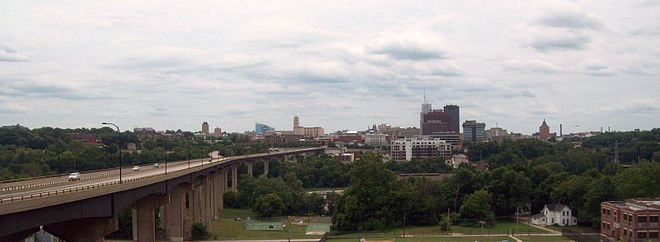
View of downtown Akron from the north; Little Cuyahoga River valley in the foreground.
History
Foundation and early years
The founding of Akron goes back to the construction of the Ohio-Erie Canal. It was intended to facilitate the transport of goods by water between the Great Lakes and the Mississippi and also to help open up Ohio, which was sparsely populated and economically backward at the time.
The settler Paul Williams, through whose property the canal was to pass, and the builder of the canal, Simon Perkins, founded in 1825, two years before the completion of the canal, at its apex a settlement called Akron. The name is derived from the Greek word ἄκρος, meaning the highest point, and referring to that very apex of that canal.
In 1833, a little farther north, above the mouth of the canal on the Little Cuyahoga River, another settlement is founded, named Cascade. This is soon called North Akron, and the original settlement is accordingly called South Akron. Finally, in 1836, the two towns are combined to form present-day Akron. However, the year of the first settlement's founding, 1825, is considered the city's founding date.
In the following years, the town grew into a small inland port. Many farmers from the surrounding area had grain loaded here. With the construction of the railroads in the mid-19th century, however, Akron initially fell behind because the railroads offered considerably faster travel speeds than canal shipping. Although the city also received rail service in 1852, economic development came to a virtual halt for a decade. It was not until the War of Secession in 1861-65 that Akron really began to industrialize; its main products were farm machinery, stoneware, matches (Barber, later Diamond Match), kerosene lamps (Akron Lamp), and oatmeal (Schumacher, later Quaker Oats). Many businesses took advantage of the supply of large quantities of fresh water through the canal.
By the 1890s, however, things were already going downhill again. Fires, epidemics and social unrest visibly eroded the industrial base. And after the focus of agriculture had additionally shifted further west, the local traders and agricultural machinery manufacturers lost their orders. Unemployment grew and numerous factories stood empty.
Rise, Great Depression and Second World War
With the beginning of the automobile age at the turn of the century, Akron rose to become the most important location of the US tire industry. With B. F. Goodrich, Firestone, General Tire and Goodyear, four of the five major US tire manufacturers were located here with their factories. This fact earned the city the nickname "Rubber Capital of the World". During this time, Akron experienced rapid population growth; the population increased from (1880) 16,500 to (1930) 255,000. Tire factories employed over 58,000 people in 1929. In 1917, Goodyear also began building airships.
The origin of this development can be traced back to Benjamin Franklin Goodrich, who moved his small rubber factory here from New York in 1870, far away from his previous competitors. After rubber manufacturing proved to be a highly profitable business due to the automobile boom after the turn of the century, other businessmen from the surrounding area also set up their own tire factories, in the direct vicinity of Goodrich and in Akron's already existing, vacant factories.
The Great Depression hit the city particularly hard. In the 1930s, the unemployment rate reached 60 % at times. It was not until the USA entered the Second World War that demand for tyres and airships began to grow again. Production during the war years also included rubber boots and raincoats for soldiers as well as components for aircraft.
During the Prohibition era (1919-33), Akron was dominated by organized crime. Illegal gambling and alcohol production flourished. In addition, the Ku Klux Klan found numerous supporters during that time; politics and administration were largely infiltrated by this organization.
Post-war period and structural change
Despite the general boom in the post-war years, Akron's industry ran into increasing difficulties after the war. Some products, such as petroleum lamps, were no longer in demand. Factory workers were also increasingly unionized and shut down production with strikes.
In particular, the worldwide conversion of production from the old cross-ply tyres to the more modern radial tyres posed major technical and financial problems for tyre manufacturers. This conversion would have required the complete retooling of existing factories, which would have meant an enormous financial burden for the companies. Thus, the US tyre industry reacted with considerable delay to the new technology, which had already been on the rise in Europe since the 1950s.
However, the oil crisis of 1973 and the associated stricter consumption standards finally forced the US car industry to convert to the new tyre design as quickly as possible. The resulting sudden pressure to innovate also meant the end of tire production in Akron. Since the conversion of production required the complete rebuilding of the associated factory facilities anyway, the companies immediately moved to other regions in the course of this, where labour was cheaper and less strongly unionised. Thus, by 1982, within ten years, almost all of Akron's production capacity had been shut down. Today, the last remaining factory produces racing tires for Goodyear on a small scale.
In addition, a strong consolidation process began in the U.S. tire industry shortly thereafter, to the detriment of the companies from Akron. General Tire sold its tire division to Continental AG in 1987. Two years later, Firestone was bought by its Japanese competitor Bridgestone. And B. F. Goodrich merged with Uniroyal in 1986 and was finally absorbed into the Michelin Group in 1990. This also eliminated the associated headquarters, so that Akron finally lost its importance for the tire industry.
The decline of the tire industry has been countered by efforts to retain at least the administrative and research facilities of the manufacturers concerned and also to attract new firms. Akron has grown into a center of polymer and plastics research and now has over 400 plastics processing companies in the area. The local schools and university also specialize in this field. In addition, the city center has experienced noticeable revitalization over the past two decades. Old factories have been converted into office buildings, several industrial wastelands have been recultivated and turned into parks; several museums, a theatre, a congress centre and a number of large sports facilities attract visitors. In recent years, wholesale trade and health care have also gained considerably in importance.
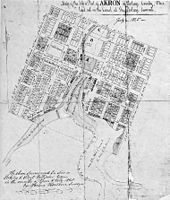
Map of Akron at the time of its founding in 1825.
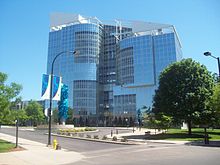
Goodyear research and development center.
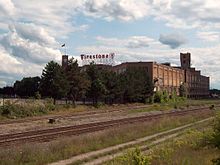
Former Firestone tire plant.
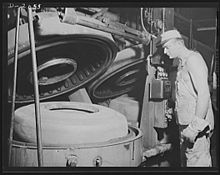
Tire Manufacturing in Akron (1941).
Search within the encyclopedia